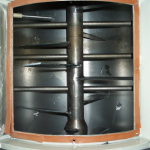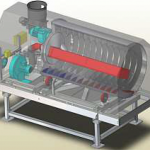In simplest terms, a crystallizer is a heating device that converts virgin, post-process, or scrap PET from an amorphous state to a semi-crystalline state.
Crystallizers are important to processors who generate or utilize large volumes of scrap or recycled PET material. Because processing causes virgin PET material to change state from semi-crystalline to amorphous material –and amorphous PET material cannot be reprocessed in high concentrations– those who must re-use this material have just two options:
- Blend a small percentage of amorphous PET regrind (10% or less) with virgin PET and then process it, or
- “Re-crystallize” the amorphous PET regrind into its semi crystalline state (like virgin PET) using a crystallizer.
What does a crystallizer do?
A crystallizer heats granulated amorphous PET to a temperature greater than its glass transition temperature, but just below its melting temperature. When the heated PET material reaches its “crystallization” temperature, the molecules of the amorphous PET rapidly change state: Crystalline structures grow and align within the molecules and the material changes from an amorphous state to a semi-crystalline state.
When the change is complete, this “crystallized” PET is ready for drying (if necessary) and processing, just like virgin material. Without crystallization, amorphous materials tend to agglomerate when they are heated up during drying. Agglomerated materials cause several problems: 1) They disrupt smooth mass flow through a drying hopper, causing some material to have insufficient residence time. 2) The large size of agglomerated clumps makes them difficult to dry and likely to retain unacceptable levels of moisture. 3) Agglomerated clumps can get stuck or bridged in downstream processes, causing a myriad of other material handling issues.
Crystallization can be done as a continuous or a batch process, depending on the capabilities of your crystallizer equipment. Typically, crystallizers are sized according to the volume of material that can be crystallized per hour.
What are the types of crystallizers?
There are two major types, both explained below:
- Hot-air hopper Crystallizers
- Infrared Drum (IRD) Crystallizers
How does a hot-air, hopper-type crystallizer work?
In many ways, these crystallizers resemble dryers: Material is fed into a hopper, heated with warmed air to a precise temperature, and then released to a downstream process. But, there are several important functional differences between a hopper-type crystallizer and a dryer:
- Crystallizers use ambient air.Crystallizers typically use heated ambient air in an open loop, not dry/desiccated air in a closed loop system (however, closed loop systems are available). So, although some drying may occur during the heating and crystallization process, crystallization does not deliver the carefully controlled moisture levels that drying does. If recrystallized PET remains moist, it must be properly dried before processing.
- Crystallizer hoppers use an agitator.因为我orphous PET material can become tacky as it is heated toward its crystallization temperature,

Internal view: Material agitator blades and stationary bars and temperature sensor (at top left). mechanical agitation is essential within the hopper to keep material moving, break up clumps, and ensure that it flows freely during and after the crystallization process.
Parts of a hot-air, hopper-type crystallizer
1. Material receiver port
2. Agitator motor and gearbox
3.Crystallization hopper
4. Material agitator blades on rotating shaft.
5. Internal temperature sensors and level switches
6. Material discharge.
7. Surge bin (Optional)
What’s an IRD crystallizer? And how is it different?
Infrared Drum (IRD) crystallizers differ from hopper-type crystallizers in several ways:
- Infrared heat source.位于at the center of the drum, an infrared emitter directly heats material as it rotates in the drum, eliminating the need to inject heated air.
- Rotating horizontal drum.Instead of a vertical hopper, the IRD uses a rotating horizontal drum. Slow, continuous rotation prevents clumping, provides thorough material mixing, and eliminates the need for the agitator used in conventional vertical crystallizer hoppers.
- 可以同时结晶和干燥。The intense infrared source heats pellets faster, driving moisture to the surface, where it is carried away by continuous stream of cool, ambient air. While IRD crystallizers are capable of removing 90% or more of moisture from material, a much higher proportion than hopper-type crystallizers, they cannot provide the precision moisture removal of a dedicated desiccant dryer.

Photo: Courtesy of Kreyenborg, GMBH Thus, some secondary drying is generally needed.
Parts of an infrared drum crystallizer
1. Material receiver
2. Material screw feed inlet
3.冷却风机和入口
4. Infrared heat source
5. Rotating drum
6. Material outlet (at right)
While the science behind crystallization and drying of post-process material may sound complicated, but using crystallizers to convert amorphous material does not need to be complex. Crystallizers simply offer PET processors a way to reduce waste and reuse material. If you have questions about how these crystallizers work, what their capabilities are, or which might be best suited to a particular type of process, don’t hesitate to call.
 724-584-5500
724-584-5500





